Analysis of the Wave Characteristics of the Baltic Sea in Terms of the Use of Wave Energy Converters
Abstract
1. Introduction
- Sea currents;
- Osmotic salinity;
- OTEC (abbreviation for Ocean Thermal Energy Conversion);
- Tides (high and low tides);
- Sea waves.
2. Materials and Methods
2.1. The Baltic Sea Energy Potential
2.2. The Baltic Sea Wave Characteristics
2.3. Selecting a Wave Energy Converter
- An oscillating water column (OWC). With an air turbine, e.g., fixed structures: Pico (Azores, Portugal)—1986–2018; LIMPET (Scotland, GB)—1987–2011; Sakata (Japan)—2011; Mutriku (Spain)—2011. Floating structures: Mighty Whale (Japan)—1998. Lower-scale European applications—OE buoy: 15 m long 1/4-scale (Ireland)—2006; Sperboy: 1/5th scale (UK)—1999–2001; Ocean Energy (Consortium), Oceanlinx (Australia)—1997.
- Oscillating bodies. Hydraulic motor, hydraulic turbine, and linear electrical generator: Floating: AquaBuOY (Ireland, Canada)—2000; IPS Buoy (Portugal)—1995; FO3 (Norway)—2009; Wavebob (Ireland)—2007; PowerBuoy (USA)—1997; Pelamis (UK)—2007; PS Frog (UK)—1990; SEAREV (France)—2002. Submerged: AWS WaveSwing (UK)—2022; Oyster (UK)—2005; WaveRoller (Portugal)—2012.
- Overtopping. Low-head hydraulic turbine: Fixed structure: TAPCHAN (Norway)—1985; SSG (Sea Slot-cone Generator) (Norway)—2004.
2.4. Wave Energy Calculation
3. Results and Discussion
4. Conclusions
- The Baltic Sea energy potential has been increasingly discussed in recent years [14,18,25]. The first WEC power plants were designed and developed for water areas with high wave energy, primarily oceans, and therefore may be less economically viable in seas with low wave energy levels. A good indicator for assessing the economic viability of a WEC power plant is the load or capacity factor, which is the ratio of the electricity generated on-site to the rated capacity (rated power) of the WEC power plant [32]. On-site electricity generation is typically estimated using a two-dimensional distribution of Hs and T and then compared to the WEC power plant’s capacity [33]. For comparison, in oceans, CF factors are typically in the range of 30–40% [25], although this is not believed to apply to seas with low energy consumption, e.g., the Baltic Sea. However, several attempts to install WECs have been reported in this area [25]. No WEC has been installed in Poland to date.
- The wave characteristics of the Baltic Sea in the Polish Exclusive Economic Zone (the Southern Baltic) have been relatively well understood thanks to the wind farm construction program. Multi-year studies have been conducted, primarily to assess the impact of wave action on wind farm monopoles, but also to address the need to reconstruct ports to accommodate service and installation ports as part of the wind farm construction program.
- A point wave energy absorber was selected for the tests, as it has a number of advantages, including compact dimensions; the removal of the need to permanently install the PA; the relative ease of installation and removal, which involves placing the PA from a ship or simply towing it to a designated location; the vertical dimensions being larger than the horizontal ones; the take-off system being a stationary part placed on the bottom, which facilitates cable routing; the relatively well-known technology for the construction and operation of buoyancy structures in the sea; and finally, the well-described method for calculating power yields from wave energy.
- The obtained calculation results in the context of Polish EEZ conditions are promising: we obtain an energy above 304 KW for 17% of the wave time per year. If we combine the data obtained from cases 2 and 3 with the upper limit of case 1, we can achieve a power yield exceeding 94 KW in about 39% of the time per year from a significant wave height of 1.23 m, and a yield reaching 186 kW in about 24.5% of the time per year from a significant wave height of 1.73 m.
- Based on three characteristic cases considered for the water area around the port of Łeba in Poland, the next step should be to design a PA wave energy converter adapted to the maximum use of the presented conditions.
Author Contributions
Funding
Institutional Review Board Statement
Informed Consent Statement
Data Availability Statement
Conflicts of Interest
References
- Farrok, O.; Ahmed, K.; Tahlil, A.D.; Farah, M.M.; Kiran, M.R.; Islam, M.R. Electrical Power Generation from the Oceanic Wave for Sustainable Advancement in Renewable Energy Technologies. Sustainability 2020, 12, 2178. [Google Scholar] [CrossRef]
- Mandal, S.; Islam, S.; Biswas, A.H.; Akter, S. A mathematical model applied to investigate the potential impact of global warming on marine ecosystems. Appl. Math. Model. 2022, 101, 19–37. [Google Scholar] [CrossRef]
- Da Silva, C.M.; Da Silva, L.L.; Souza, T.D.C.; Dantas, T.C.; Correa, S.M.; Arbilla, G. Main Greenhouse Gases levels in the largest secondary urban forest in the world. Atmos. Pollut. Res. 2019, 10, 564–570. [Google Scholar] [CrossRef]
- Otawa, A.; Skomudek, W. Innovative solutions in the field of renewable energy sources based on selected examples. In Innowacje w Zarządzaniu i Inżynierii Produkcji; Knosala, R., Ed.; Oficyna Wydawnicza Polskiego Towarzystwa Zarządzania Produkcją: Opole, Poland, 2018. (In Polish) [Google Scholar]
- Farrok, O.; Islam, M.R.; Sheikh, M.R.I.; Guo, Y.G.; Zhu, J.G. Design and Analysis of a Novel Lightweight Translator Permanent Magnet Linear Generator for Oceanic Wave Energy Conversion. IEEE Trans. Magn. 2017, 53, 8207304. [Google Scholar] [CrossRef]
- Krawiec, F. Renewable Energy Sources in the Light of the Energy Crisis: Selected Problems; Wydawnictwo Difin: Warszawa, Poland, 2010. (In Polish) [Google Scholar]
- Lewandowski, W.M. Eco-Friendly Renewable Energy Sources; Wydawnictwo Naukowo-Techniczne: Warszawa, Poland, 2010. (In Polish) [Google Scholar]
- Jagusiak, B.; Stochaj, J. Renewable energy to meet energy needs. Przegląd Nauk.-Metodyczny. Eduk. Dla Bezpieczeństwa 2018, 1, 702–716. (In Polish) [Google Scholar]
- REN21. Renewables 2016 Global Status Report; REN21 Secretariat: Paris, France, 2016; Available online: https://www.ren21.net/wp-content/uploads/2019/05/REN21_GSR2016_FullReport_en_11.pdf (accessed on 30 August 2025).
- REN21. The First Decade: 2004–2014—10 Years of Renewable Energy Progress; REN21 Secretariat: Paris, France, 2014; Available online: https://www.ren21.net/Portals/0/documents/activities/Topical%20Reports/REN21_10yr.pdf (accessed on 30 August 2025).
- International Energy Agency. Implementing Agreement on Ocean Energy Systems. Annual Report 2007. Available online: https://www.ocean-energy-systems.org/publications/oes-annual-reports/document/oes-annual-report-2007/ (accessed on 30 August 2025).
- Curto, D.; Franzitta, V.; Guercio, A. Sea Wave Energy. A Review of the Current Technologies and Perspectives. Energies 2021, 14, 6604. [Google Scholar] [CrossRef]
- Cascajo, R.; García, E.; Quiles, E.; Correcher, A.; Morant, F. Integration of marine wave energy converters into seaports: A case study in the port of Valencia. Energies 2019, 12, 787. [Google Scholar] [CrossRef]
- Falcão, A.F.d.O. Wave energy utilization: A review of the technologies. Renew. Sustain. Energy Rev. 2010, 14, 899–918. [Google Scholar] [CrossRef]
- Molla, S.; Farrok, O.; Islam, M.R.; Muttaqi, K.M. Analysis and design of a high performance linear generator with high grade magnetic cores and high temperature superconducting coils for oceanic wave energy conversion. IEEE Trans. Appl. Supercond. 2019, 29, 5201105. [Google Scholar] [CrossRef]
- Krzemień, Z. Using the Energy of Sea Waves to Produce Electricity; Prace Instytutu Elektrotechniki: Warszawa, Poland, 2013; Volume 262. [Google Scholar]
- Heino, H. Possibilities of wave energy in the Baltic Sea. In Utilisation of Wave Power in the Baltic Sea Region; Finland Futures Research Centre: Turku, Finland, 2013; pp. 33–39. [Google Scholar]
- Soomere, T.; Eelsalu, M. On the wave energy potential along the eastern Baltic Sea coast. Renew. Energy 2014, 71, 221–233. [Google Scholar] [CrossRef]
- Ocean Energy Systems. Oceans of Energy—European Ocean Energy Roadmap 2010–2050. Available online: https://www.ocean-energy-systems.org/publications/icoe/icoe-2010/document/oceans-of-energy-european-ocean-energy-roadmap-2010-2050/ (accessed on 10 July 2025).
- Eurostat. Renewable Energy Statistics. Available online: https://ec.europa.eu/eurostat/statistics-explained/index.php?title=Renewable_energy_statistics (accessed on 10 July 2025).
- Kasiulis, E.; Punys, P.; Kofoed, J.P. Assessment of theoretical near-shore wave power potential along the Lithuanian coast of the Baltic Sea. Renew. Sustain. Energy Rev. 2015, 41, 134–142. [Google Scholar] [CrossRef]
- Kovaleva, O.; Eelsalu, M.; Soomere, T. Hot-spots of large wave energy resources in relatively sheltered sections of the Baltic Sea coast. Renew. Sustain. Energy Rev. 2017, 74, 424–437. [Google Scholar] [CrossRef]
- Gunn, K.; Stock-Williams, C. Quantifying the global wave power resource. Renew. Energy 2012, 44, 296–304. [Google Scholar] [CrossRef]
- IMGW. Climate of Poland 2023. Available online: https://www.imgw.pl/sites/default/files/inline-files/climate-of-poland-2023_report.pdf (accessed on 10 July 2025).
- Foteinis, S. Wave energy converters in low energy seas: Current state and opportunities. Renew. Sustain. Energy Rev. 2022, 162, 112448. [Google Scholar] [CrossRef]
- Analysis of Wave and Debris Flow Along the Ports and in the Ports of Rowy and Łeba, Volume I, Łeba. Available online: https://www.umgdy.gov.pl/wp-content/uploads/2022/06/Raport-analiza-falowania.pdf (accessed on 16 July 2025).
- Falnes, J.; Kurniawan, A. Ocean Waves and Oscillating Systems: Linear Interactions Including Wave-Energy Extraction; Cambridge University Press: Cambridge, UK, 2020; Volume 8. [Google Scholar]
- Falnes, J. Optimum control of oscillation of wave-energy converters. In Proceedings of the ISOPE International Ocean and Polar Engineering Conference, Stavanger, Norway, 17–22 June 2001; p. ISOPE-02-12-2-147. [Google Scholar]
- WECs: Calculating Power Output Using Wave Characteristics. Available online: https://eepower.com/technical-articles/wecs-calculating-power-output-using-wave-characteristics/# (accessed on 16 July 2025).
- Other Physical Characteristics of Ocean Water: Density. Available online: https://zpe.gov.pl/a/przeczytaj/DGQNhapow (accessed on 16 July 2025).
- Zhang, X.; Tian, X.; Xiao, L.; Li, X.; Chen, L. Application of an adaptive bistable power capture mechanism to a point absorber wave energy converter. Appl. Energy 2018, 228, 450–467. [Google Scholar] [CrossRef]
- Rusu, E. Evaluation of the Wave Energy Conversion Efficiency in Various Coastal Environments. Energies 2014, 7, 4002–4018. [Google Scholar] [CrossRef]
- Onea, F.; Rusu, E. Sensitivity analysis of the wave energy converters operating in the French coastal waters. Int. J. Smart Grid Clean Energy 2019, 8, 239–244. [Google Scholar] [CrossRef]
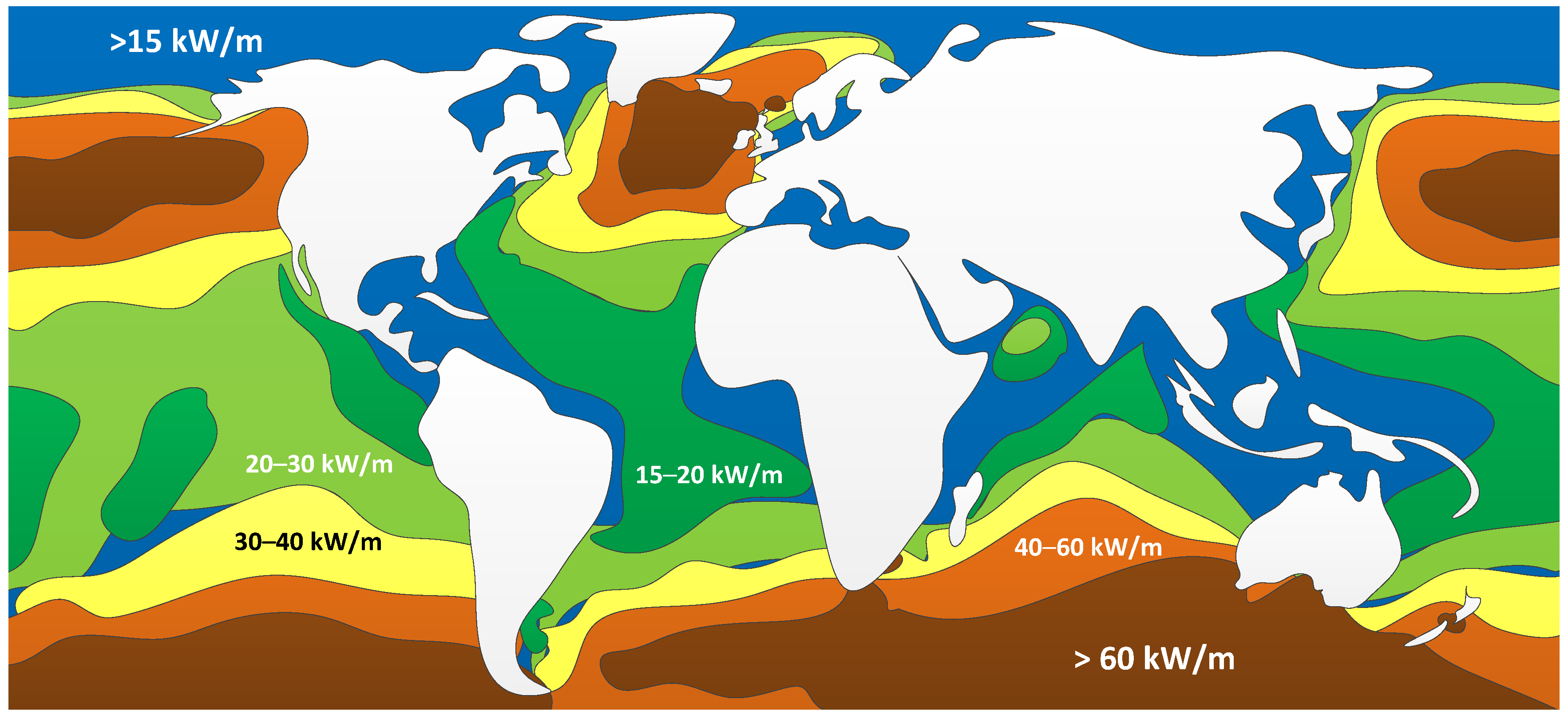
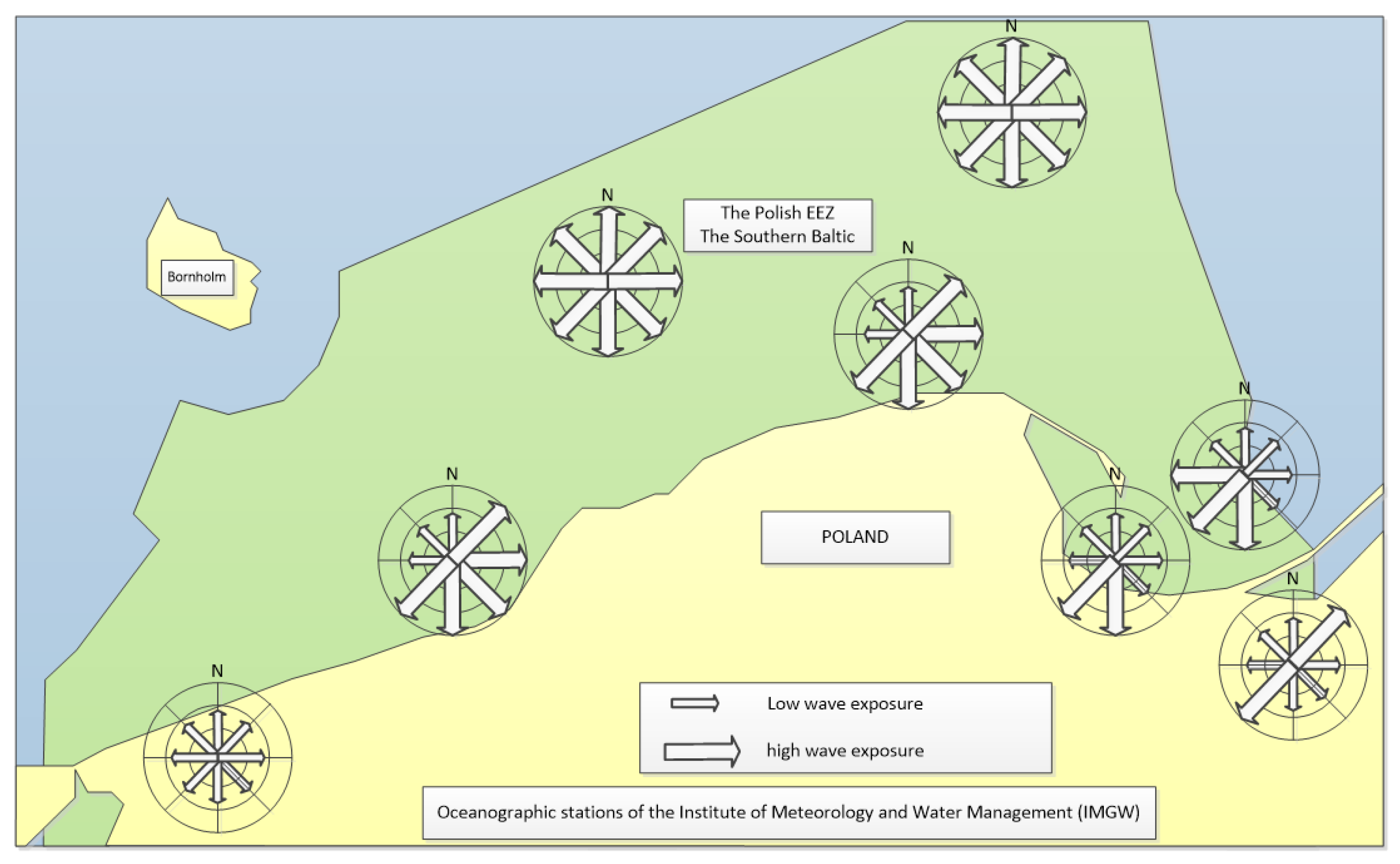

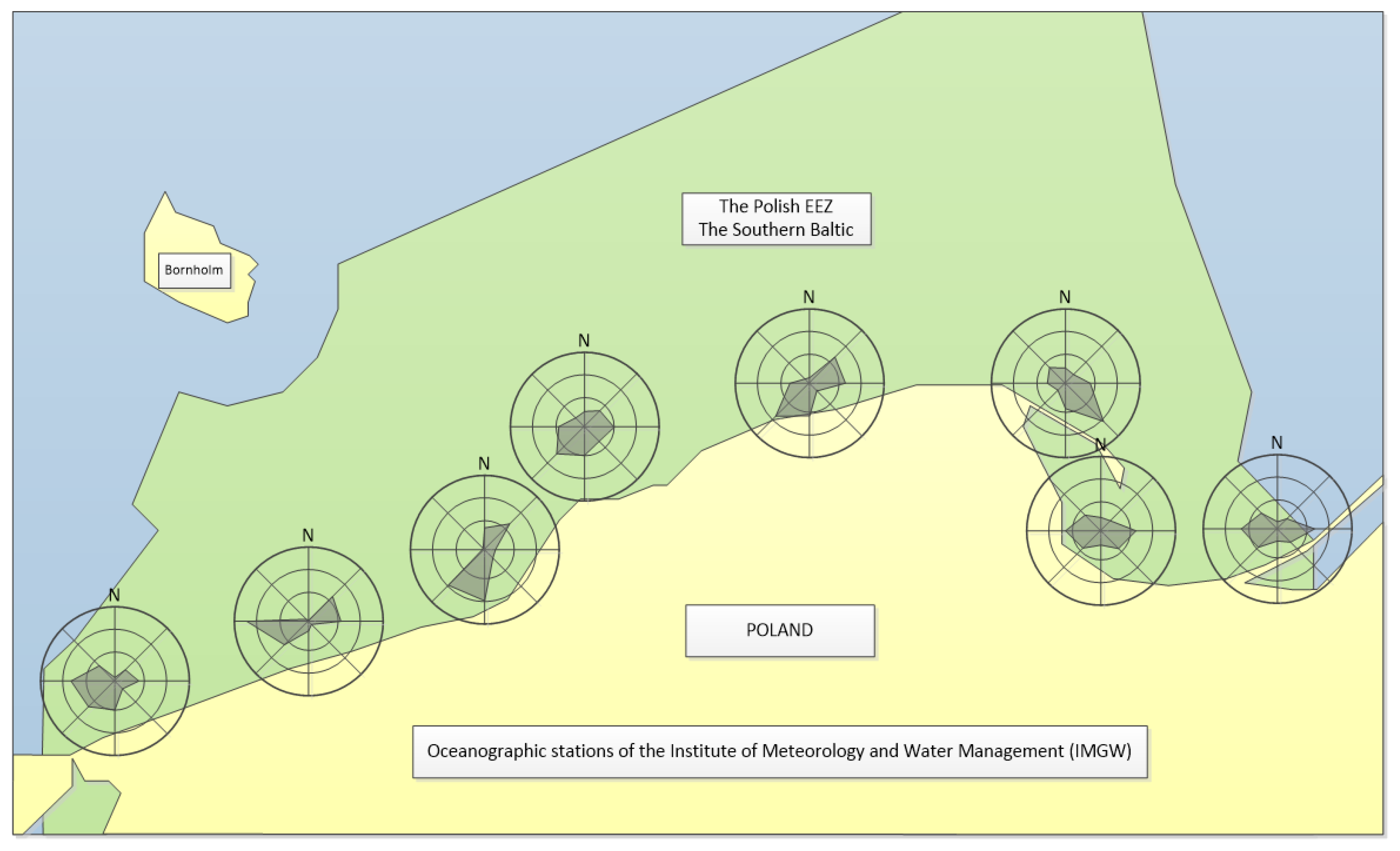
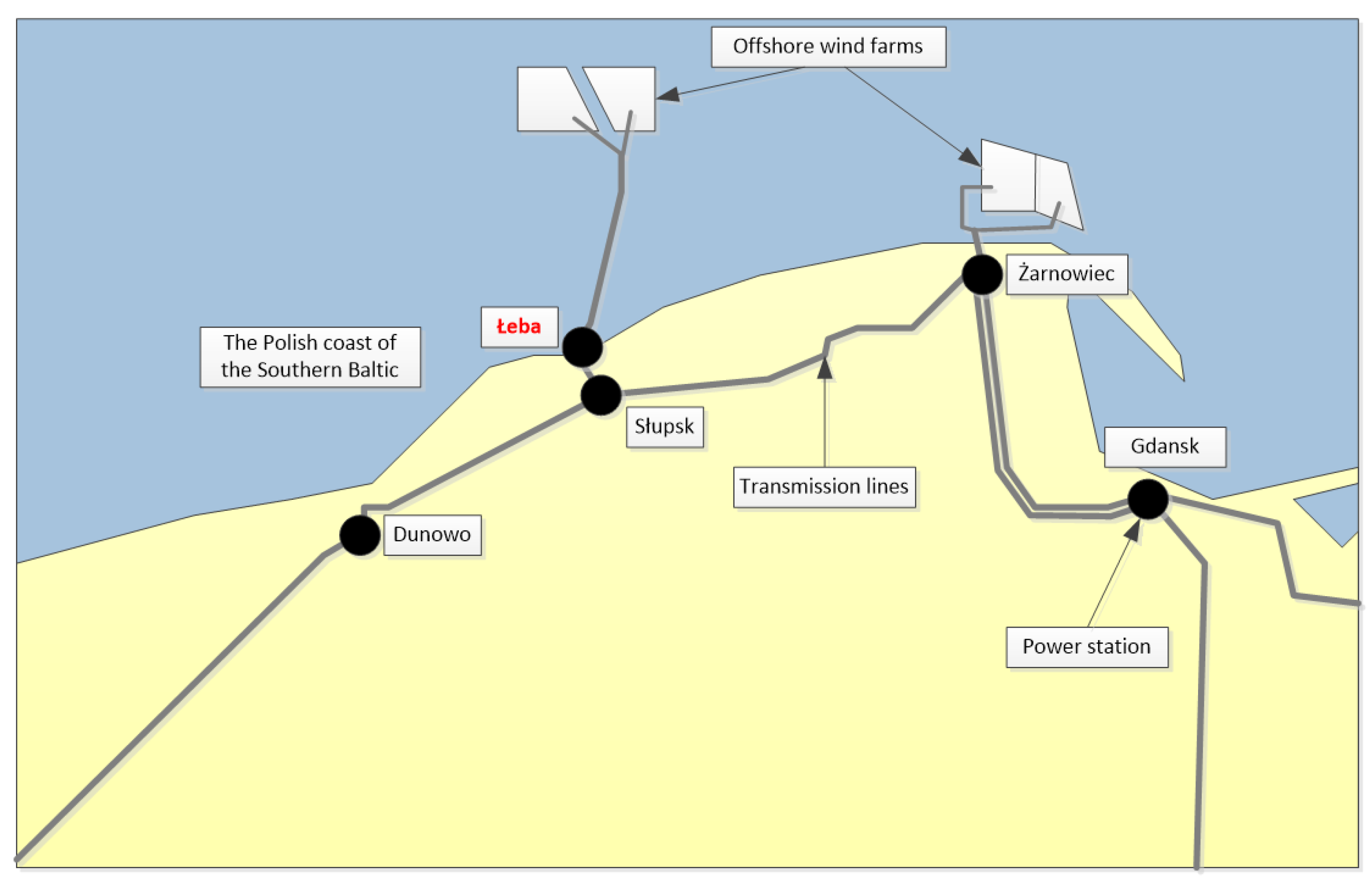
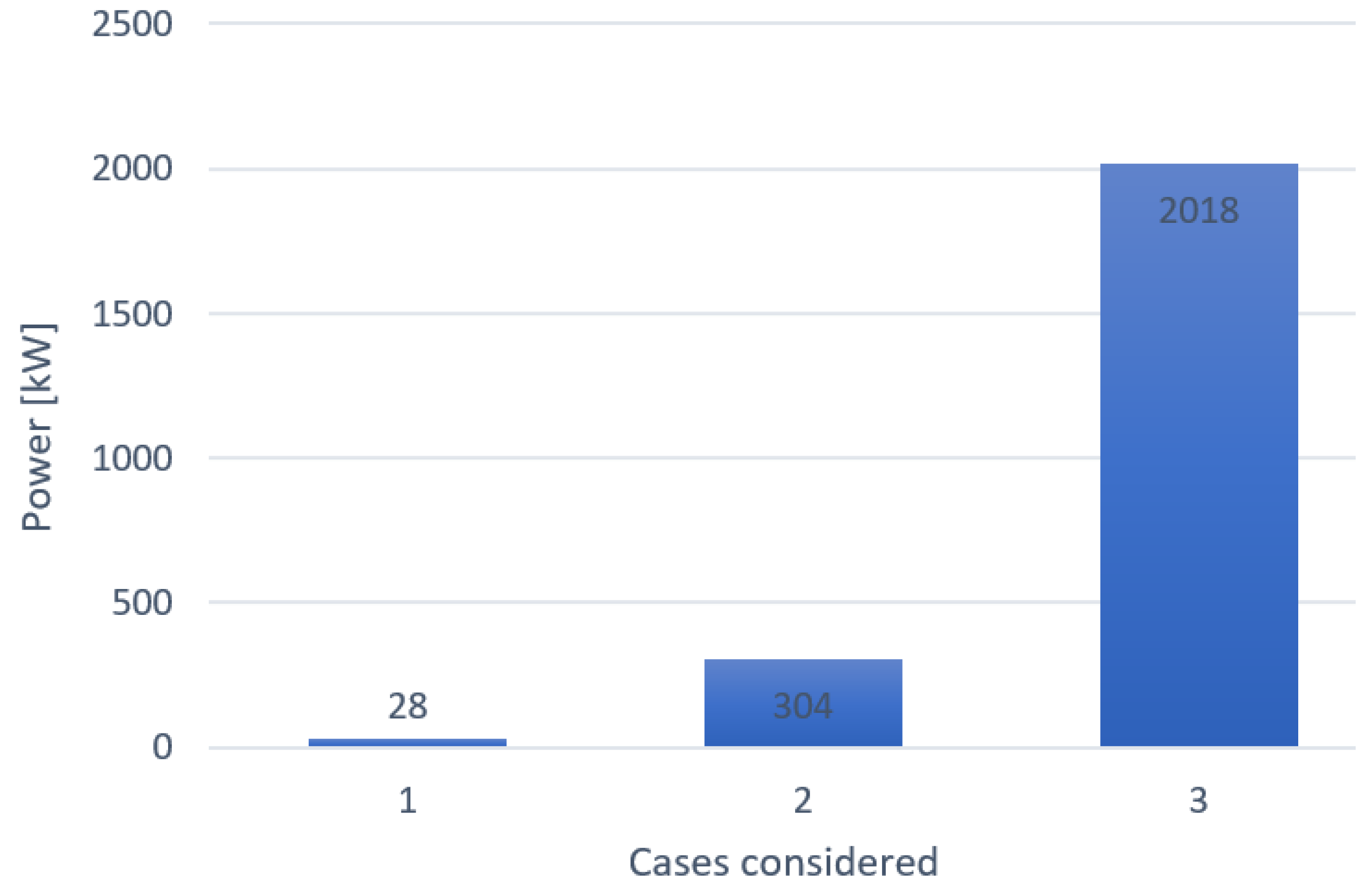
| Primary Energy Sources | Natural Energy Conversion Processes | Technical Energy Conversion Processes | Form of Energy | |
|---|---|---|---|---|
| Sun | Water | Evaporation, melting of ice and snow, precipitation | Hydroelectric power plants | Electricity |
| Wind | Movement of the atmosphere | Wind power plants | Thermal and electrical energy | |
| Wave Energy | Wave power plants | |||
| Solar radiation | Ocean currents | Ocean current power plants | Electricity | |
| Heating of the Earth’s surface and atmosphere | Ocean heat power plants | Electricity | ||
| Heat pumps | Thermal energy | |||
| Solar radiation | Collectors and thermal solar power plants | Thermal energy | ||
| Photovoltaic cells and solar power plants | Electricity | |||
| Photolysis | Fuels | |||
| Biomass | Biomass production | Heating and thermal power plants | Thermal and electrical energy | |
| Conversion devices | Fuels | |||
| Gravity | Tides of water | Tidal power plants | Electricity | |
| Earth | Isotope decay | Geothermal sources | Geothermal heating and power plants | Thermal and electrical energy |
| Nuclear energy | Nuclear power plants | Electricity | ||
| Moon | Gravity | Tides of water | Tidal power plants | Electricity |
| Types of Energy | Advantages | Disadvantages |
|---|---|---|
| Hydropower | No emissions of substances that would accompany energy conversion | Interference with the natural environment |
| It has greater potential than nuclear energy. | A source dependent on water supplies, which may cause problems with obtaining energy during droughts and low water levels. | |
| Population displacement | ||
| Wind energy | Wind farms can be located on land and at sea | Requires appropriate wind conditions, which are very uneven around the world |
| High availability of the source | Wind turbines emit noise | |
| No costs associated with obtaining the raw material | Turbines can cause radio interference | |
| Relatively low processing costs | Turbines pose a threat to birds moving around their edges | |
| Low adverse impact on the environment | Wind turbines can negatively affect the landscape and thus reduce the attractiveness of the places where they are built | |
| Power plants can be built on unused land | Instability of the energy obtained due to changing wind intensity | |
| Solar power | Available in all regions of the world | Uneven solar exposure across the world |
| Environmentally friendly (no emissions or noise) | High cost of photovoltaic installations | |
| Dependence on atmospheric conditions | ||
| Biomass | One of the cleanest sources of energy | Biomass requires a lot of space Affects biodiversity Requires a lot of water |
| Produced from waste and residues | ||
| Geothermal Energy | Independent of atmospheric conditions | Necessity to create very deep holes |
| Low operating costs of energy extraction installations | To produce electricity, it is necessary to reach water at a temperature of at least 100 °C | |
| Risk of water pollution |
| No | WEC Advantages | WEC Disadvantages |
|---|---|---|
| 1. | Renewable Energy—Changes in gravitation and wind generate waves. These sources will never end. | Location-dependent solutions—always close to the water. |
| 2. | Protecting the natural world, less carbon footprint, and no soil damage. | Influence on marine ecosystem—e.g., underwater noise is treated as environmental pollution. |
| 3. | Plenty and easily accessible—oceans cover approximately 71% of the Earth’s surface. | High initial cost and maintenance cost that is currently difficult to estimate because there is a limited number of solutions and a relatively short operational period. |
| 4. | Cut back on the reliance on overseas energy giants. | Cruising disturbance for recreational and commercial ships. |
| 5. | Extensive methods for harnessing—a lot of different types of WEC. | Currently, prototype solutions dominate—problems with connection to the power grid (mostly microgeneration). |
| 6. | Reliable—constant source of energy. | Advances in technology are moving very slowly. |
| 7. | Extremely high levels of energy can be generated. | Forecasting fully accurate wave power is highly unpredictable. |
| 8. | Adaptation to the environment—specific place and dedicated technical solution. | - |
| Energy of the Seas and Oceans | Power (GW) | Potential Production (TWh/Year) |
|---|---|---|
| Tides (high and low tides) | 90 | 800 |
| Sea currents | 5000 | 50,000 |
| Osmotic salinity | 20 | 2000 |
| Ocean thermal energy conversion (otec) | 1000 | 10,000 |
| Ocean and sea waves | 1000–9000 | 8000–80,000 |
| Country | Wave Energy Potential (TWh/Year) | |
|---|---|---|
| Coastal | Offshore | |
| UK | 43–64 | 14–21 |
| Ireland | 21–32 | 7–11 |
| Portugal | 12–18 | 4–6 |
| France | 12–18 | 3–5 |
| Spain | 10–16 | 3–5 |
| Italy | 9–16 | 3–5 |
| Denmark | 5–8 | 2–3 |
| Greece | 4–7 | 1–2 |
| Germany | 0.9–1.4 | 0.3–0.5 |
Disclaimer/Publisher’s Note: The statements, opinions and data contained in all publications are solely those of the individual author(s) and contributor(s) and not of MDPI and/or the editor(s). MDPI and/or the editor(s) disclaim responsibility for any injury to people or property resulting from any ideas, methods, instructions or products referred to in the content. |
© 2025 by the authors. Licensee MDPI, Basel, Switzerland. This article is an open access article distributed under the terms and conditions of the Creative Commons Attribution (CC BY) license (https://creativecommons.org/licenses/by/4.0/).
Share and Cite
Listewnik, K.J.; Mindykowski, J. Analysis of the Wave Characteristics of the Baltic Sea in Terms of the Use of Wave Energy Converters. Appl. Sci. 2025, 15, 10078. https://doi.org/10.3390/app151810078
Listewnik KJ, Mindykowski J. Analysis of the Wave Characteristics of the Baltic Sea in Terms of the Use of Wave Energy Converters. Applied Sciences. 2025; 15(18):10078. https://doi.org/10.3390/app151810078
Chicago/Turabian StyleListewnik, Karol Jakub, and Janusz Mindykowski. 2025. "Analysis of the Wave Characteristics of the Baltic Sea in Terms of the Use of Wave Energy Converters" Applied Sciences 15, no. 18: 10078. https://doi.org/10.3390/app151810078
APA StyleListewnik, K. J., & Mindykowski, J. (2025). Analysis of the Wave Characteristics of the Baltic Sea in Terms of the Use of Wave Energy Converters. Applied Sciences, 15(18), 10078. https://doi.org/10.3390/app151810078






